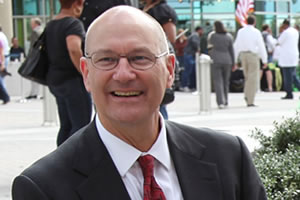A new arts director took the helm for the City of Raleigh late last year and he argues the arts not only benefit from growth, but help bring people, jobs and investments to the city.

Jerry Bolas began working as Raleigh's Art Director Dec. 5. Photo provided by City of Raleigh.
Arts Commission Executive Director Jerry Bolas began his new job Dec. 5, succeeding June Guralnick, who resigned in July.
“I was thrilled at the prospect of being involved here,” Bolas said. “Raleigh’s arts scene in the last few years has been just growing in terms of both the quality of the arts and the quantity of the arts. And so it’s very exciting to be able to come to a community where things are growing and active and where the arts are growing.”
Bolas has been active in the arts across the state for nearly two decades. He arrived in North Carolinain 1994 to direct the Ackland Art Museum at the University of North Carolina-Chapel Hill. In 2006, he became an independent consultant with clients including the Southeastern Center for Contemporary Art, North Carolina Arts Council, Arts Council of Winston-Salem and Forsyth County, and Cary Visual Art.
From 2009-2011, he served as chair of the Chapel Hill Arts Commission. Most recently, his role as a consultant brought him into contact with the Raleigh Arts Commission. Now, he will be leading the organization, overseeing the expenditure of the group’s annual $2 million budget.
The Raleigh Arts Commission is comprised of 12 denizens, appointed by the City Council, who are charged with developing and guiding the policies surrounding the city’s investment in the arts. As executive director, Bolas and his staff members will work with the Arts Commission, city staff members and volunteers to distribute those dollars, manage new and existing public art and arts awards programs and help generate interest inRaleigh’s arts scene.
It’s a challenge during tough budget times. The City reduced arts funding last year per capita by 50 cents to $4 per capita.
2010-11: $1.7 million
2011-12: $1.6 million
Difference: -8 percent
About three-quarters of the Arts Commission budget is doled out each year to arts groups such as the Carolina Ballet, Raleigh Little Theater, Artspace, Artsplosure and others.
Bolas said more groups than ever applied last year for arts funding, including about a dozen new groups. He said it’s a sign ofRaleigh’s art expansion.

Expanding art in Raleighis one of his goals, and not even a new one. Bolas previously worked with the city to help implement the Percent for Art program. In 2009, the city approved an ordinance requiring one half of one percent of municipal construction funds to be set aside for public art.
The first site selected for integration of public art is the Buffaloe Road Aquatics Center, expected to open this spring.
He also has curated local temporary public art projects, including the inaugural Art on CityPlazaexhibition, and managed the installation of Jim Gallucci’s “Immigrant Gate II” sculpture at Millbrook Exchange Park.
Bolas comes from an academic background and once created works of visual art. Now, he saidRaleighis his campus and his art is working to make art more available to the public.
“So I think of my campus as about 140 square miles,” he said. “Think of these different arts, creative departments, arts and art venues as spread throughout that campus. The question is how we in the arts commission — our mission is to take taxpayer investment and invest it wisely in growing the arts for the benefit of our community.”
Those benefits are many, Bolas said, from the cultural and educational benefits to, yes, economic, helping attract other resources such as tourism and jobs.
“The work is part of a package that makesRaleigha destination,” he said. “Our taxes are lowered because people come and leave money behind. The arts also have a role in … making Raleigh a great place for companies to want to move because the people who are coming can visualize that they, their families and their employees’ families will enjoy living in the community.”
Raleigh’s position of growth presents an opportunity, Bolas said. He’s looking ahead, visualizing how art might impact future neighborhoods such as the one that will likely appear around Union Station.
“What is the neighborhood around that station going to look like? Many might agree that what we’d like to have is a destination so that when people are passing through Union Station, you hope they can stop inRaleighand have time to go out into a really exciting environment and experience an arts and entertainment district that they want to hang out in,” he said.
His vision is part of why Bolas was chosen for the job, said Diane Sauer, director of the Parks and Recreation Department, which oversees the arts office.
“What Jerry brings to the table is incredible experience, incredible passion and incredible passion to moveRaleigharts to the next level,” she said.
Working in the arts is a calling, Bolas said, and he’s glad he has the opportunity to guideRaleigh’s artistic future.
“It’s a great privilege to invest public money in nurturing the arts for the benefit of the community,” he said. “If you think about growing the arts inRaleigh, it’s a project that people have been working on for decades and one that’s going to continue to be worked on for decades. It’s not something that gets solved or fixed or done. And I think that from my perspective it’s fun to be part of something that’s … I would say inRaleigh’s case, I would think of it as more emerging and moving into an established as a well-known as a national venue.”
